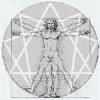“In relation to the musical (seven-tone) scale it is generally considered (theoretically) that there are two semitones between each two notes, with the exception of the intervals mi-fa and SI-DO, which have only one semitone and in which one semitone is regarded as being left out. Fragments: Seven
“In this manner twenty notes are obtained, eight of which are fundamental: do, re, mi, fa, sol, la, si, do; and twelve intermediate: two between each of the following two notes: do-re re-mi fa-sol sol-la la-si; and one between each of the following two notes: mi-fa SI-DO. “But in practice, that is, in music, instead of twelve intermediate semitones only five are taken, that is one semitone between: do-re re-mi fa-sol sol-la la-si. “Between mi and fa and between si and do the semitone is not taken at all. Fragments: Seven
“In this way the structure of the musical seven-tone scale gives a scheme of the cosmic law of ‘intervals,’ or absent semitones. In this respect when octaves are spoken of in a ‘cosmic’ or a ‘mechanical’ sense, only those intervals between mi-fa and SI-DO are called ‘intervals’ Fragments: Seven
“The octave possesses seven tones and the eighth is a repetition of the first. Together with the two ‘additional shocks’ which fill the ‘intervals’ mi-fa and SI-DO, there are nine elements. Fragments: Fourteen
“The isolated existence of a thing or phenomenon under examination is the closed circle of an eternally returning and uninterruptedly flowing process. The circle symbolizes this process. The separate points in the division of the circumference symbolize the steps of the process. The symbol as a whole is do, that is, something with an orderly and complete existence. It is a circle — a completed cycle. It is the zero of our decimal system; in its inscription it represents a closed cycle. It contains within itself everything necessary for its own existence. It is isolated from its surroundings. The succession of stages in the process must be connected with the succession of the remaining numbers from 1 to 9. The presence of the ninth step filling up the ‘interval’ SI-DO, completes the cycle, that is, it closes the circle, which begins anew at this point. The apex of the triangle closes the duality of its base, making possible the manifold forms of its manifestation in the most diverse triangles, in the same way as the point of the apex of the triangle multiplies itself infinitely in the line of its base. Therefore every beginning and completion of the cycle is situated in the apex of the triangle, in the point where the beginning and the end merge, where the circle is closed, and which sounds in the endlessly flowing cycle as the two do’s in the octave. But it is the ninth step that closes and again begins a cycle. Therefore in the upper point of the triangle corresponding to do stands the number 9, and among the remaining points are disposed the numbers 1 to 8. Fragments: Fourteen
“Now if we recall the law of octaves we shall see that a balanced process proceeding in a certain way cannot be changed at any moment it is desired. It can be changed and set on a new path only at certain ‘cross-roads.’ In between the ‘crossroads’ nothing can be done. At the same time if a process passes by a ‘crossroad’ and nothing happens, nothing is done, then nothing can be done afterwards and the process will continue and develop according to mechanical laws; and even if people taking part in this process foresee the inevitable destruction of everything, they will be unable to do anything. I repeat that something can be done only at certain moments which I have just called ‘crossroads’ and which in octaves we have called the ‘intervals’ mi-fa and SI-DO. Fragments: Fifteen

